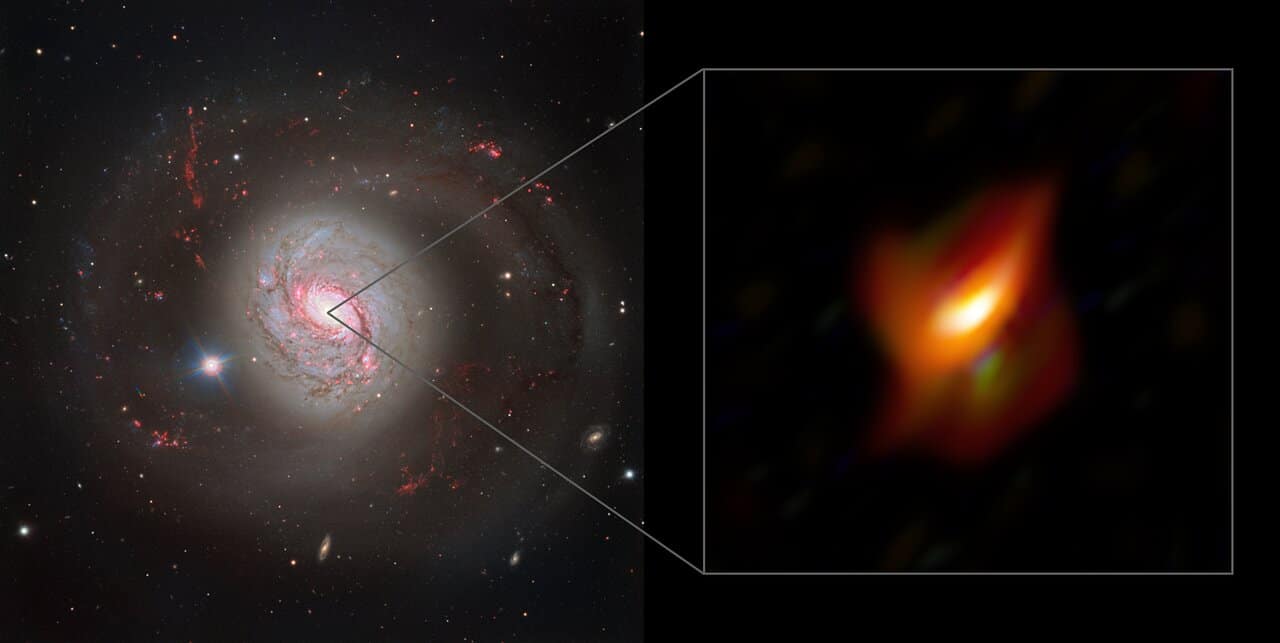

At the heart of the Messier 77 galaxy is a supermassive black hole hidden in a ring of cosmic dust. And that confirms a 30-year-old theory.
Active galactic nuclei (abbreviation AGN) are still enigmatic objects. What we know is that they are extremely energetic and luminous sources that are located at the center of some galaxies. Ever since these bright objects were first noticed in the 1950s, astronomers have been curious about them. And now researchers have taken an important step in understanding how they work and what they look like up close.
AGNs are among the most energetic objects in the universe, powered by supermassive black holes. These black holes feed on large amounts of cosmic dust and gas. Before being engulfed, this material spirals toward the black hole, releasing enormous amounts of energy. As a result, an active core often shines more brightly than all the stars in the surrounding galaxy put together. In fact, they can even shine brighter than supernovae!
In the new study, the research team examined using the Very Large Telescope Interferometer (VLTI) of the European Southern Observatory (ESO) the galaxy Messier 77. This galaxy is located 47 million light-years away in the constellation Whale (Cetus). A supermassive black hole at the center of the galaxy is believed to be responsible for the high energy emissions that take place there. By studying this system, the researchers hoped to unravel more secrets about AGNs.
Shapes and sizes
Meanwhile, we know that AGNs come in different shapes and sizes. For example, some produce bursts of radio emissions. Other specimens are bright sources of visible light while others – including those in Messier 77 – are somewhat more dim.
Prevailing theory
The prevailing theory – which it Unified Model of AGNs is that despite the major differences between them, all AGNs have the same basic structure: they consist of a supermassive black hole, surrounded by a thick ring of dust. Researchers therefore suspect that the different appearances are simply the result of the angle at which we observe the black hole and the thick ring from Earth. The type of AGN depends on the extent to which the ring hides the black hole from view and in some cases even hides it completely.
Hide and seek
This is indeed the case in Messier 77. By making extraordinarily detailed observations of the galaxy’s center, researchers have now discovered a thick ring of cosmic dust and gas that hides a supermassive black hole. In other words, at the heart of the Messier 77 galaxy is a supermassive black hole hidden in a cloud of cosmic dust.

Supermassive black hole hidden in a ring of cosmic dust. Image: ESO/Jaffe, Gámez-Rosas et al
The discovery confirms that enigmatic AGNs seem to be a good hide-and-seeker. It therefore provides crucial evidence for the Uniform Model and the predictions made some thirty years ago.
The discovery provides astronomers with new insight into AGNs. “The true nature of the dust clouds and their role in both feeding the black hole and determining what it looks like from Earth have been at the center of AGN research for the past three decades,” explains researcher Violeta Gámez Rosas. “While no single result will answer all of our questions, we have now taken an important step towards a better understanding of how AGNs work. In addition, they could help us better understand the history of our Milky Way Galaxy, which harbors a supermassive black hole at its center that may have been active in the past.”
Investigation into puzzling AGNs continues. The plan is to once again deploy ESO’s VLT and survey a larger sample of galaxies to find more supporting evidence for the Uniform Model. In addition, the Extremely Large Telescope (ELT), which will become operational later this decade, will also open the hunt for AGNs. This powerful telescope is believed to be even more capable of studying the interaction between AGNs and galaxies.
Source material:
†Supermassive black hole hidden in a ring of cosmic dust” – ESO
Image at the top of this article: ESO